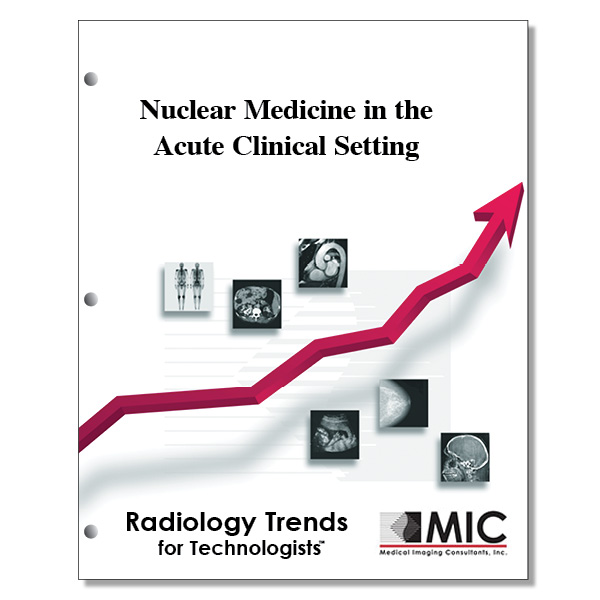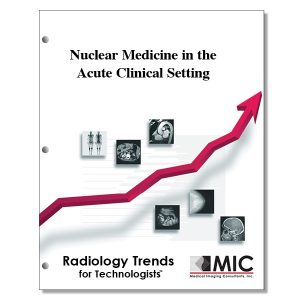

Nuclear Medicine in the Acute Clinical Setting
The spectrum of nuclear medicine studies commonly performed in the acute care setting is reviewed.
Course ID: Q00377 Category: Radiology Trends for Technologists Modality: Nuclear Medicine3.75 |
Satisfaction Guarantee |
$37.00
- Targeted CE
- Outline
- Objectives
Targeted CE per ARRT’s Discipline, Category, and Subcategory classification:
[Note: Discipline-specific Targeted CE credits may be less than the total Category A credits approved for this course.]
Nuclear Medicine Technology: 3.75
Procedures: 3.75
Radionuclides and Radiopharmaceuticals: 1.25
Cardiac Procedures: 0.50
Gastrointestinal and Genitourinary Procedures: 1.00
Other Imaging Procedures: 1.00
Registered Radiologist Assistant: 2.50
Procedures: 2.50
Abdominal Section: 1.25
Thoracic Section: 0.25
Neurological, Vascular, and Lymphatic Sections: 1.00
Outline
- Introduction
- Hepatobiliary Scintigraphy
- Clinical Indications in the Acute Care Setting
- Imaging Modalities and Radiopharmaceuticals
- Scintigraphic Findings and Pitfalls
- Acute Cholecystitis
- Perforated Cholecystitis
- Bile Leak
- Choledocholithiasis
- GI Tract Scintigraphy
- Clinical Indications in the Acute Care Setting
- Imaging Modalities and Radiopharmaceuticals
- Scintigraphic Findings and Pitfalls
- Gastric Bleeding
- Small Bowel Bleeding
- Colonic Bleeding
- Scintigraphy of the Native Kidney
- Clinical Indications in the Acute Care Setting
- Imaging Modalities and Radiopharmaceuticals
- Scintigraphic Findings and Pitfalls
- Renal Transplant Scintigraphy
- Clinical Indications in the Acute Care Setting
- Imaging Modalities and Radiopharmaceuticals
- Scintigraphic Findings and Pitfalls
- Myocardial Perfusion Scintigraphy
- Clinical Indications in the Acute Care Setting
- Imaging Modalities and Radiopharmaceuticals
- Scintigraphic Findings and Pitfalls
- Lung Scintigraphy
- Clinical Indications in the Acute Care Setting
- Imaging Modalities and Radiopharmaceuticals
- Scintigraphic Findings and Pitfalls
- Central Nervous System Scintigraphy
- Brain Scintigraphy for Cerebral Perfusion Assessment
- Clinical Indications in the Acute Care Setting
- Imaging Modalities and Radiopharmaceuticals
- Scintigraphic Findings and Pitfalls
- CSF Shunt Scintigraphy
- Clinical Indications in the Acute Care Setting
- Imaging Modalities and Radiopharmaceuticals
- Scintigraphic Findings and Pitfalls
- Brain Scintigraphy for Cerebral Perfusion Assessment
- Conclusion
Objectives
Upon completion of this course, students will:
- be familiar with the advantages of nuclear medicine imaging when compared to other common imaging modalities
- identify the imaging techniques associated with nuclear medicine imaging
- be familiar with the combined use of CT with SPECT and PET imaging
- understand which nuclear imaging procedure is indicated for acute cholecystitis
- understand the advantages of US as a first-line imaging study for acute gallbladder disease
- be familiar with causes of false-positive findings on hepatobiliary scintigraphy
- be familiar with the physiological effects of cholecystokinin
- identify the risk factors for gallbladder disease
- understand the patient preparation for hepatobiliary scintigraphy
- be familiar with single photon emission computed tomography
- identify the primary indication for GI tract scintigraphy
- identify the initial diagnostic tests for upper GI tract bleeding
- be familiar with the radionuclide used to tag RBCs for GI tract scintigraphy
- understand the sensitivity of GI tract scintigraphy
- be familiar with the active bleeding detection levels for GI tract scintigraphy
- understand the potential false-positive findings due to Crohn disease
- identify the causes of colonic bleeding
- identify the radiopharmaceuticals used for GI tract scintigraphy
- be familiar with the use of US as the first-line modality to evaluate the urinary system
- be familiar with the most commonly used radiopharmaceutical for diuretic renal scintigraphy
- identify the potential causes of false-positive findings of urinary system obstruction while performing renal scintigraphy
- be familiar with detector positioning when performing renal scintigraphy on native kidneys
- be familiar with the dynamic acquisitions performed during renal scintigraphy
- identify the normal residual radiotracer amount at 20 minutes post-injection when performing renal scintigraphy
- identify the clinical manifestations of renal graft dysfunction and/or acute rejection
- be familiar with the preferred radiopharmaceutical for renal transplant scintigraphy
- identify why post-operative ureteral obstruction commonly occurs at the ureterovesical anastomosis in renal transplant patients
- be familiar with radiotracer activity that can mimic a urine leak during renal transplant scintigraphy
- be familiar with the camera detector position used during renal transplant scintigraphy
- be familiar with the indications for using MPI in the acute setting
- identify the radiopharmaceuticals used for perfusion lung scintigraphy
- be familiar with the MPI imaging set performed in the acute setting
- be familiar with the ino/chronotropic drug use for pharmacological MPI
- identify the MPI radiopharmaceutical that redistributes and has the highest cardiac extraction fraction
- be familiar with the sensitivity and specificity of pulmonary CT angiography
- be familiar with the radiopharmaceutical used for perfusion lung scintigraphy
- be familiar with the proper patient position during the injection of 99mTc MAA
- be familiar with the nuclear medicine imaging test used to evaluate brain death
- be familiar with the two most common CSF shunts
- identify the radiopharmaceuticals that cross the intact blood brain barrier
